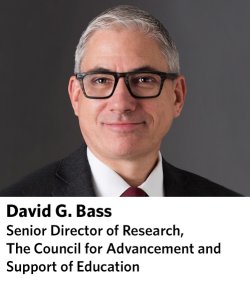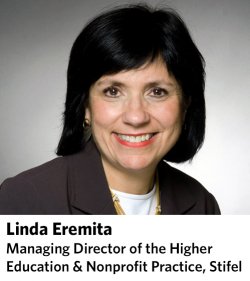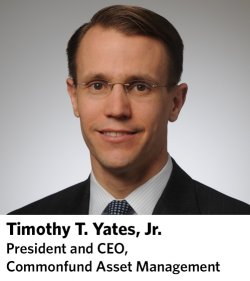Commonfund convenes an expert panel to take on the short- and intermediate-term threats that higher education confronts in the face of a national emergency the likes of which have not been seen for 100 years.

With COVID-19 exploding every expectation of normalcy in U.S. higher education, Commonfund convened a panel of experts to identify, analyze and offer potential responses to the critical challenges confronting institutions today and in the weeks and months ahead.
The panel was moderated by Tim Yates, President and CEO of Commonfund Asset Management. The panelists were: David Bass, Director of Research, the Council for the Advancement and Support of Education (CASE); Rick Beyer, Senior Fellow, the Association of Governing Boards (AGB); Linda Eremita, Managing Director, Higher Education & Nonprofit Practice, Stifel Financial Corporation; and Joel Wilson, Trustee and Investment Committee Chair, Valparaiso University.
Tim Yates: Linda, what are the immediate financial challenges facing higher ed today concerning their access to debt? What’s the thinking relative to debt on balance sheets?
Linda Eremita: While colleges and universities are seeing their long-term investment portfolios lose value, on the liability side of the balance sheet are their debt instruments. Most institutions carry long-term indebtedness in the form of public bonds issued to fund projects such as science buildings, student housing, and recreational facilities. That debt, mostly tax-exempt, typically carries a 30 year maturity. Debt service payments over that span typically occupy a small percentage of an institution’s operating budget—5 percent or less. And because most of it is fixed-rate debt, interest payments don’t change during a crisis like this, making debt service very predictable.

— David Bass

Recent access to debt by colleges and universities merits a look. In 2017, 310 public bond issues were sold to fund approximately $33 billion of college and university projects as well as to refinance their debt. Approximately $19 billion, or 60 percent, was issued by public institutions and 40 percent by private institutions. Moving to 2018, 171 public bond issues totaling $14 billion were issued, with a 47/40 percent public/private colleges split, with the remainder funding privatized housing. In 2019, due to a very attractive interest rate environment, total borrowing increased to $23.5 billion, with 59 percent funding public institutions and 36 percent funding private institutions with the balance once again funding privatized student housing. So where are we in early 2020? Since January 1, bonds totaling a very high $10 billion have been issued, 70 percent by public institutions and 30 percent by private institutions. Rates have been incredibly attractive—their lowest ever.
During the week of March 9 that virtually ended. Only four AA-rated college and university issues were sold that week. After that, rates began to increase and the primary bond market froze. Between January 2 and March 24, 30 year rates jumped a minimum of 100 basis points for the most creditworthy borrowers, and far more for lower-rated credits. Interest on variable rate debt has averaged 2 ½ percent since 1985 with a low of half a percent over the last 10 years. Last week we saw weekly tax-exempt rates reset between 5 ½ and 8 ½ percent.
Nevertheless, we are somewhat hopeful at the moment. Why? Because, as many financial market participants have said, the Federal Reserve will win. The Fed has said it will purchase Treasury and open market short-term securities to support this market, and we are seeing it begin to work.
Yates: Given developments in the bond and money markets, should colleges and universities be concerned about liquidity?
Rick Beyer: Liquidity in this situation is probably going to be the number one item for many institutions. This is where a deep, comprehensive review of anything that impacts cash flow and liquidity will be required. Just looking at things on the surface and making some predictions will not be adequate. There needs to be a look that goes three, four, five levels deep into anything that could impact liquidity.
Eremita: I agree. If you’re accustomed to a 4 or 5 percent annual draw on your endowment that’s now going to mean something drastically different, depending on where your total investment portfolio sits at the end of the day. It’s going to be very important to figure out what that draw is going to look like for the next operating budget. A lot of institutions, because of demographic challenges, have already implemented changes in the number of faculty and other employees. Maybe an institution that has never had to draw on an operating line of credit will have to do so now. If you may need a line to be increased, that’s something that you should already be talking to your bank about.
Yates: Rick, on top of these challenges from a debt perspective, many if not all colleges have sent students home, canceled classes and shifted to distance learning environments. Now there’s a lot of discussion around refunding tuition and room and board and offering credits or discounts. What are you seeing with respect to current fiscal year budget implications as a result of sending all the paying customers home?
Beyer: Schools were past mid-point of the second semester by the time everybody was sent home, meaning that 33 to 37 percent of room and board costs remained. On the board side, usually, third parties are delivering that service and there will be a pretty substantial cost of goods sold coming from foodservice providers. To the extent that institutions have shut that off, there’s an opportunity at some level for a refund because the margins on food service at colleges are pretty low. On the room side, margins tend to be higher. Here, it is important for colleges to focus on trying to retain students and developing a strategy to incentivize them to return to campus next fall.
Yates: Boards generally meet quarterly and are charged with the long-term strategic direction of the institution. Joel, how engaged has your board been with management over the past few weeks? Forget strategic direction for a moment, what should board members be doing right now? How can they best help?

— Joel Wilson
 Joel Wilson: Recognizing that boards are not built to respond to or deal with tactical administrative challenges—and remembering that we’re still early in the process—the board needs to understand and support the administration’s actions. It doesn’t need to be calling every day. It doesn’t need to be sending emails. Right now, the administrative staffs at all institutions are overwhelmed trying to deal with conditions on the ground. At Valparaiso, we decided to channel all of our comments, suggestions, offers of help and so forth through our board chair, who then summarizes and categorizes them for his daily briefing with the president. For the rest of the board, we suspended regular business for our scheduled April meeting because the staff just doesn’t have the time and bandwidth to prepare for a full board meeting. At the committee level, we’re doing all of our work through telephone and conference calls. So, in sum, it’s most important right now that boards offer support and not add to the pressure that administrations are under, bearing in mind that every day presents them with a new set of challenges.
Joel Wilson: Recognizing that boards are not built to respond to or deal with tactical administrative challenges—and remembering that we’re still early in the process—the board needs to understand and support the administration’s actions. It doesn’t need to be calling every day. It doesn’t need to be sending emails. Right now, the administrative staffs at all institutions are overwhelmed trying to deal with conditions on the ground. At Valparaiso, we decided to channel all of our comments, suggestions, offers of help and so forth through our board chair, who then summarizes and categorizes them for his daily briefing with the president. For the rest of the board, we suspended regular business for our scheduled April meeting because the staff just doesn’t have the time and bandwidth to prepare for a full board meeting. At the committee level, we’re doing all of our work through telephone and conference calls. So, in sum, it’s most important right now that boards offer support and not add to the pressure that administrations are under, bearing in mind that every day presents them with a new set of challenges.
Yates: Rick and Linda, you have served and continue to serve on boards. Anything either of you would add to Joel’s comments?
Beyer: I totally agree that boards really need to remain strategic and not overwhelm the administration with tactical issues. That’s where the board can be very, very helpful—by remaining strategic and not over-thinking tactical challenges. They can’t lose sight of what they’re trying to accomplish for the fall and beyond.

— Linda Eremita

Eremita: I also agree and would like to add that, especially if you’re on the finance committee, you want to understand how many unrestricted dollars are on the balance sheet at the current time. You also want to understand if your institution has a liquidity facility, such as a line of credit, and whether that line is a demand line or a committed line, which is the better of the two. You probably already know about your debt portfolio, but you might want to review what’s been provided to you in the past. You also want to know that your institution has all of the technical support that it needs because everything is online. That’s the lifeline to students—if that doesn’t work, that’s a problem. Finally, it’s important to listen to your institutions when they ask you to write letters or join them in their communications with legislators. If there’s ever been an important time to garner support for higher education, COVID-19 is it.
Yates: David, in prior downturns we have looked to donors to help fund different initiatives or offset declines in endowment income or other revenues. Is that happening yet? What are development teams doing today and what is the short-term outlook for giving?
David Bass: I think there is absolutely going to be a significant short-term impact on charitable giving to colleges and universities. There is a direct correlation between charitable giving and economic growth and market performance. There’s also a fairly direct correlation between charitable giving and confidence. Over the past 60-some years, total charitable giving (not just to higher education) has grown at an average annual rate, adjusted for inflation, of 3.3 percent. During years of economic growth the average increased to an average rate of 4.7 percent, but during years marked by economic downturns, average charitable giving actually decrease by .05 percent. Even major donors who are very secure financially are probably not going to choose to liquidate assets in this current moment. I read some data recently from a poll of advancement officers at colleges and universities conducted by a major fundraising consultancy indicating that 85 percent of them expect the current crisis to have a major impact on giving in the next 30 days. Further out, there’s a lot more uncertainty and I wouldn’t hazard an opinion.
To your question about what development teams are doing at the present moment, first of all, they are absolutely adjusting their plans and rethinking how they engage with donors. No surprise that the majority of them are canceling or postponing scheduled visits and a good number are transitioning some of those to virtual or online meetings. I think the real story is that in dealing with major donors, they’re focusing on stewardship, that is, reaching out to donors and friends of the institution who have been loyal supporters to understand what’s going on in their own lives, allowing them to learn what the institution is doing and just sustaining those relationships rather than forging ahead with planned asks. So, the focus for institutions at the present moment needs to be engagement, listening and being sensitive to what’s going on with your donors.
At the other end of the spectrum, institutions are rethinking plans for things like end-of-year appeals and annual fund drives. A lot of institutions have elected to cancel or postpone events like that, feeling it would be tone-deaf at the present time. Some of them, though, have elected to repurpose by shifting the focus to raising funds to support students who may be struggling. One final piece of work that they’re all doing is working with colleagues across the institution to gain an understanding of what the implications will be as endowment funds go underwater and if the institution’s priorities are shifting. Those big, strategic priorities are really what drive the bulk of fundraising, so getting a read on the need to recalibrate long-term purposes and priorities is rising to the top.
Yates: There’s a lot to think about in the short term, but I want to turn to the intermediate term. Admittedly, that feels like it’s now measured in weeks, but if we look into the summer and fall, I’m curious to hear some perspectives about where we go from here.

— Rick Beyer
 Beyer: Let’s start with the fact that before this pandemic, higher education on a national basis had already experienced eight consecutive years of enrollment decline. And in the last couple of years, only one-third of institutions made their enrollment numbers. I think it’s going to be critically important for institutions to take their budget for fiscal 2021 and put it aside for a moment to forecast a range of results—starting with revenue—and assume that they will have to manage to the downside. We could see changing behaviors by students coming out of high school that shift them more towards community colleges or an online environment. Institutions that are in high demand may have to go deeper into their pool to meet their numbers. Institutions that are not in as much demand are going to be challenged—we are likely to see tuition discounting continue to go up. It’s important for institutions to think about changing their operating rhythms because right now is prime-time enrollment season. Institutions will have to look at the difference between applications and admissions and work the gaps to get as many students as possible who qualify for admission actually admitted. The other area that can fall between the cracks is financial aid packaging. Institutions will need to think about doing things differently, including issuing financial aid packages without a Free Application for Federal Student Aid (FAFSA) submission. Clearly, a student would still need to have a FAFSA completed to receive government funding, but schools can use service, speed, and statistics to help determine financial aid packages, and get those full financial aid packages out to prospective students.
Beyer: Let’s start with the fact that before this pandemic, higher education on a national basis had already experienced eight consecutive years of enrollment decline. And in the last couple of years, only one-third of institutions made their enrollment numbers. I think it’s going to be critically important for institutions to take their budget for fiscal 2021 and put it aside for a moment to forecast a range of results—starting with revenue—and assume that they will have to manage to the downside. We could see changing behaviors by students coming out of high school that shift them more towards community colleges or an online environment. Institutions that are in high demand may have to go deeper into their pool to meet their numbers. Institutions that are not in as much demand are going to be challenged—we are likely to see tuition discounting continue to go up. It’s important for institutions to think about changing their operating rhythms because right now is prime-time enrollment season. Institutions will have to look at the difference between applications and admissions and work the gaps to get as many students as possible who qualify for admission actually admitted. The other area that can fall between the cracks is financial aid packaging. Institutions will need to think about doing things differently, including issuing financial aid packages without a Free Application for Federal Student Aid (FAFSA) submission. Clearly, a student would still need to have a FAFSA completed to receive government funding, but schools can use service, speed, and statistics to help determine financial aid packages, and get those full financial aid packages out to prospective students.
Yates: What’s going to happen with international students? There’s something like 1 million of them enrolled in higher ed here in the U.S. and they can be full-pay and in some cases also fill demographic gaps
for colleges.
Beyer: Colleges should ask what is the probability of international students’ enrollment increasing for the fall, and what is the probability of it decreasing for the fall? There’s a better bet that it’s going to be a decline no matter what. We’re going to see an impact that will cause tuition discounting to start to come into international markets.
Yates: David, let’s come back to fundraising. Looking out over the next six to nine months, what adjustments need to be made? We know it’s a long-term strategy involving building and maintaining relationships over years. What can development professionals be doing today to ensure that they don’t lose that long-term momentum?
Bass: I was looking back at some data from CASE’s Voluntary Support for Education Survey before and after the 2008 financial crisis. In 2008, institutions received what was a record high of $31.6 billion in private support. In fiscal year 2009, in the immediate wake of the crisis, donations to colleges and universities fell by $3.75 billion, or just about 12 percent. That was about the steepest plunge in over 50 years of surveying institutions on their fundraising. And it was particularly pronounced for private liberal arts colleges, many of which depend on fundraising for a significant part of their operating budget. They showed a decline in giving of almost 19 percent year over year. It wasn’t until fiscal year 2013 that total voluntary support to colleges and universities rebounded to meet and exceed 2008’s high.
To your point about fundraising being a long-term game, that is going to be crucial for both boards and administrations to keep top of mind. The good news is that donors to higher education are tremendously loyal. They don’t just look at themselves as contributors but as strategic partners and investors. They’re going to want to help institutions adapt, they’re going to want to help institutions address the new challenges posed by COVID-19. They want to change the world, and there are some really compelling things that need changing right now.
 Yates: An endowment-related question to close: Joel, what should investment committees be doing right now? Should they be shifting their strategy, their portfolios? Maybe more importantly, what should they not be doing?
Yates: An endowment-related question to close: Joel, what should investment committees be doing right now? Should they be shifting their strategy, their portfolios? Maybe more importantly, what should they not be doing?
Wilson: Institutions need to focus on any long-term structural changes that come out of all this, and have both the analytical tools and the advisory relationships that will help inform board and investment committee decisions, as well as strengthen their internal communication and decision-making processes. Closely related is strategic planning: Has the current crisis changed any long-term strategic objectives? Has it eliminated any? Has it accelerated any? Are your modeling tools robust enough to test a wide range of assumptions? If any of those apply, in what way will the outcome of strategic decisions change investment objectives and asset allocations?
We touched on the balance sheet earlier in this conversation. In that light, you need to ask if endowment objectives are in line with any changes in strategic planning objectives. Are your debt structures aligned? Are your working capital lines intact and available? And if online becomes the primary delivery system for instruction, how does that affect fixed assets that may become nonstrategic?



